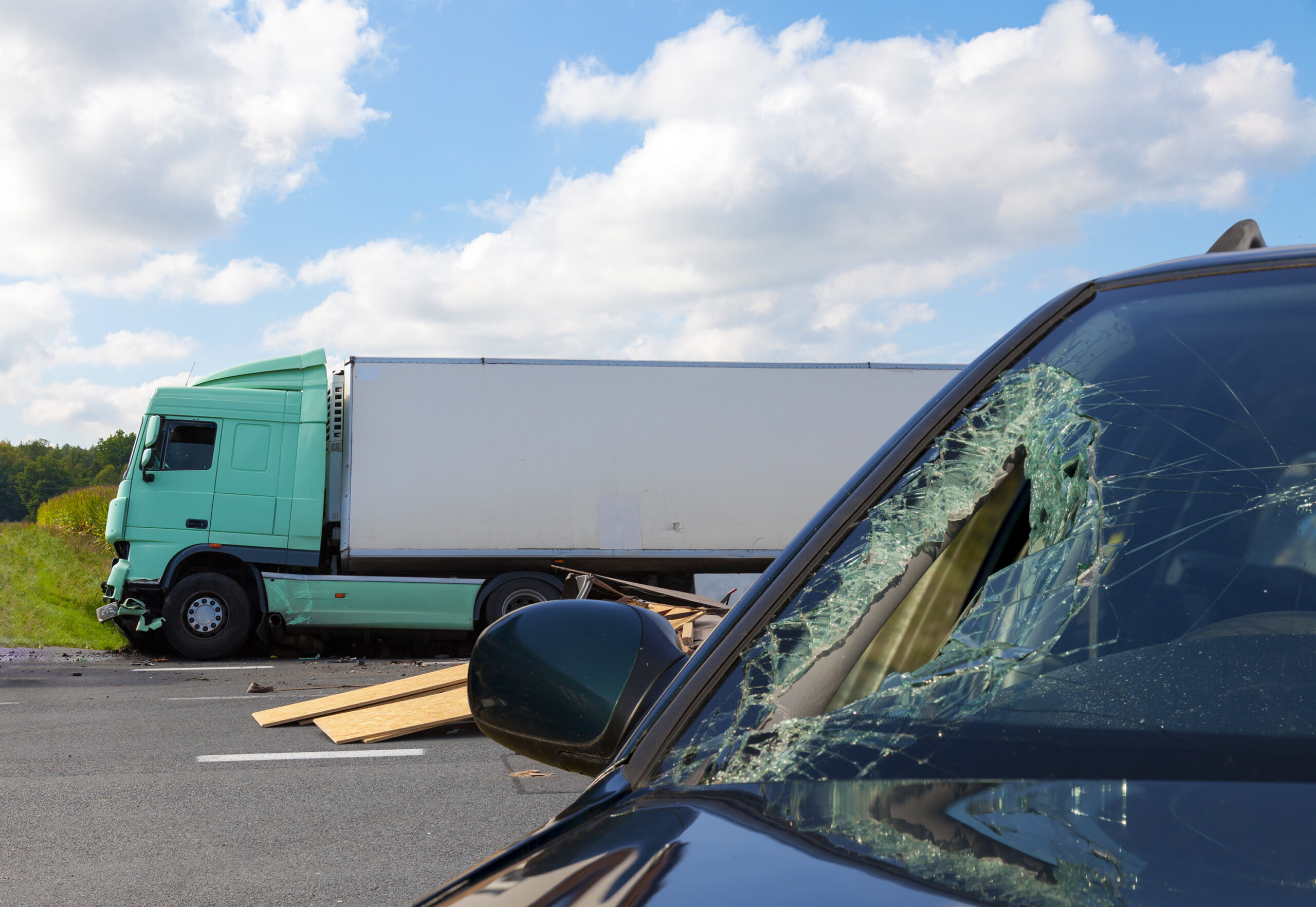Being in a truck accident can be incredibly stressful. You might feel confused and unsure about what to do next. We’re here to help you through the legal process and support you. Our goal is to make you feel more confident as you seek justice and compensation for your injuries.
First Steps After a Truck Accident in New York
After a truck accident, taking the right steps is crucial for your case. First, seek medical attention, even for minor injuries. Medical records are vital evidence for your case. They help prove the extent of your injuries. Also, gather information at the scene. Take photographs, note witness contacts, and document details about the truck and its driver. This information can strengthen your claim.
When you contact an attorney, they will start an initial investigation. They will review police reports, medical records, and any evidence you collected. Your attorney may also conduct further investigations. This could involve obtaining data from the truck’s electronic logging device or requesting maintenance records. These details can reveal the cause of the accident and identify responsible parties.
Determining Liability in a Truck Accident Case
Truck accidents are often more complex than other vehicle accidents. Multiple parties may be involved. Liability can extend beyond the truck driver. The trucking company, the vehicle’s manufacturer, and the cargo loading company can all contribute to the accident. Your attorney will work to identify all potentially liable parties. They will analyze evidence and consult industry professionals. Determining liability is crucial for pursuing compensation. It ensures all responsible parties are held accountable. This process can take time, but it is necessary to build a strong case.
Negotiations and Insurance Companies
Insurance companies play a significant role in truck accident lawsuits. Trucking companies and their insurers often use aggressive defense tactics. They aim to minimize payouts. Remember, their primary goal is to protect their financial interests, not to ensure you are fairly compensated.
Your attorney will handle all communications with the insurance companies. This allows you to focus on your recovery. They will negotiate settlements that reflect the full extent of your losses, including medical expenses, lost wages, and pain and suffering. If a fair settlement cannot be reached, your attorney is prepared to take your case to trial.
Filing a Lawsuit and the Legal Process
If negotiations don’t lead to a satisfactory settlement, your attorney will file a lawsuit. This begins the formal legal process, which has several stages. After filing, both sides enter a phase called discovery. During discovery, each party exchanges evidence and information. This can include depositions, interrogatories, and document requests. Discovery is often the longest phase of a lawsuit. It is essential for uncovering evidence that strengthens your case. Your attorney will use this time to prepare for trial. They will analyze evidence, consult witnesses, and build a persuasive argument.
The Trial Phase and What to Expect
If your case goes to trial, it will be heard in court. Both sides will present their arguments. Your attorney will advocate for you. They will present evidence, question witnesses, and explain the accident’s impact on your life. The trial phase can be intimidating, but your attorney will guide you. They will ensure you are prepared and supported every step of the way. The length of a trial can vary, depending on the case’s complexity. The ultimate goal is to secure a favorable verdict. A successful outcome can provide the financial compensation you need to recover from the accident.
The Importance of Evidence in Truck Accidents
Evidence is critical in all accidents, especially truck ones. Trucks are large and can cause significant damage. This makes the legal process more complex. Evidence helps identify who is at fault and shows the extent of damage. It can also indicate if the truck driver broke any laws or if the truck had issues. Presenting evidence builds a clear picture of the accident. Without it, proving fault is tough. More evidence makes your case stronger and helps hold the right parties accountable.
Types of Evidence to Collect
After a truck accident, gather various evidence. This includes photos, witness statements, police reports, and medical records. Each type plays a role in showing what happened and who is at fault.
Photos are crucial. They capture vehicle damage, road marks, and vehicle positions. This helps recreate the scene. Witness statements also matter. They provide support for your account of the accident. Collect evidence quickly after an accident. Valuable details can be lost over time. For example, road marks can fade, and vehicles might be moved. Weather can also change the scene. So, acting fast is vital. The sooner you collect evidence, the more accurate it will be. Take photos and notes right after the accident. Memories fade, so early documentation is crucial.
Why Witnesses Matter in Truck Accident Cases
In many truck accident cases, witnesses are brought in to explain technical or scientific issues that are beyond the knowledge of the average person. When an accident happens, there are often several factors at play that could cause the crash. The road conditions, the weather, how fast the vehicles were moving, and how the truck was loaded all may have contributed to the accident. Truck accidents are also different from regular car accidents because trucks are much bigger, heavier, and harder to control. This means that accidents involving trucks often result in more serious injuries and damage. Understanding all of the factors involved in a truck accident requires someone who can explain these details clearly to the court.
Truck accident cases also usually involve questions of negligence, meaning that the court needs to determine if someone was at fault for the accident. In order to prove negligence, it is important to show that someone acted in a way that was careless or unsafe, which caused the accident to happen. Witnesses can provide insight into whether the truck driver or another party was acting in a way that put others in danger. This can include explaining things like whether the truck was being operated safely, if the truck driver was following the rules of the road, or if the truck had been maintained properly. This kind of information is key in proving fault in a truck accident case.
Common Types of Witnesses in Truck Accident Cases
There are different types of witnesses who may be called upon to provide testimony in truck accident cases. These individuals may come from various fields of work and bring their knowledge to the courtroom to explain certain aspects of the case. One common type of witness in truck accident cases is someone who can explain how the accident happened. This person may review the details of the crash, such as the speed of the vehicles, the distance between them, and the condition of the truck and the road. By analyzing this information, they may help the court understand who was at fault and how the accident occurred.
Another important type of witness is one who provides medical information. Truck accidents often result in severe injuries, and the court needs to understand the extent of these injuries. Medical witnesses can explain the nature of the injuries, how they affect the victim, and what kind of treatment is necessary. They can also help the court understand the long-term impact of these injuries, such as whether the victim will need ongoing medical care or if they will be unable to work in the future.
In addition to these witnesses, someone may be needed to explain the trucking industry itself. Trucking is a highly regulated industry, and there are strict rules that drivers and companies must follow to ensure safety on the roads. These rules cover things like how many hours a driver can be on the road without rest, how trucks must be loaded, and how they are inspected and maintained. A witness with knowledge of these regulations can help the court determine whether the truck driver or company followed these rules. If they did not, this could be evidence of negligence.
Steps to Take After a Truck Accident in New York
Truck accidents can be incredibly traumatic, often resulting in severe injuries, extensive property damage, and significant emotional distress. If you find yourself involved in a truck accident in New York, it is crucial to take specific steps to protect your health, legal rights, and financial interests. Understanding these steps can make a substantial difference in the aftermath of such an incident. This comprehensive guide will walk you through the necessary actions to take after a truck accident in New York, ensuring you are well-prepared to handle the situation effectively.
Ensure Safety and Seek Medical Attention
The immediate aftermath of a truck accident can be chaotic and overwhelming. Your first priority should be ensuring the safety of everyone involved. If possible, move your vehicle to a safe location away from traffic to prevent further accidents. Turn on your hazard lights to alert other drivers. Once you are in a safe place, check yourself and others for injuries. Even if injuries seem minor, it is essential to seek medical attention as soon as possible. Some injuries, such as internal bleeding or traumatic brain injuries, may not be immediately apparent but can have serious long-term consequences. Medical documentation of your injuries will also be crucial for any legal or insurance claims.
Contact Law Enforcement
It is imperative to contact law enforcement after a truck accident. The police will create an official accident report, which is an essential piece of documentation for your case. When the police arrive, provide them with a factual account of the incident without admitting fault. Be honest and clear in your statements. The police report will include details about the accident, witness statements, and any traffic violations that may have occurred. This report can serve as valuable evidence when dealing with insurance companies or pursuing legal action.
Gather Evidence at the Scene
While waiting for law enforcement to arrive, if you are physically able, start gathering evidence at the accident scene. Take photographs of the vehicles involved, focusing on the damage sustained by each. Capture images of the surrounding area, including traffic signs, road conditions, and any skid marks. If there are any visible injuries, photograph those as well. Exchange contact and insurance information with the truck driver and any other parties involved. Additionally, collect contact information from any witnesses who may have seen the accident. Their statements can provide crucial support for your case.
Notify Your Insurance Company
Promptly notify your insurance company about the accident. Provide them with the necessary details and cooperate fully during the claims process. However, be cautious when discussing the accident with insurance adjusters. Insurance companies may try to minimize their liability by offering quick settlements that do not fully cover your damages. It is advisable to consult with an attorney before accepting any settlement offers. An experienced attorney can help you navigate the insurance claims process and ensure you receive fair compensation for your injuries and losses.
Seek Legal Representation
Truck accidents often involve complex legal and insurance issues. It is in your best interest to seek legal representation from a qualified attorney who has experience handling truck accident cases. An attorney can help you understand your rights, evaluate the merits of your case, and guide you through the legal process. They can also assist in negotiating with insurance companies and, if necessary, represent you in court. Having a knowledgeable attorney on your side can significantly improve your chances of obtaining the compensation you deserve.
Document Your Injuries and Expenses
Maintaining thorough documentation of your injuries and expenses is critical for building a strong case. Keep a detailed record of all medical treatments, including doctor visits, hospital stays, medications, and rehabilitation. Save all medical bills, receipts, and invoices related to your treatment. Additionally, document any other expenses incurred as a result of the accident, such as transportation costs, home modifications, or lost wages. This documentation will help your attorney accurately calculate the full extent of your damages and pursue appropriate compensation.
Follow Through with Medical Treatment
It is essential to follow through with all recommended medical treatments and appointments. Adhering to your doctor’s instructions not only aids in your recovery but also demonstrates the seriousness of your injuries to insurance companies and the court. Skipping appointments or disregarding medical advice can be used against you to undermine your claim. Consistent medical treatment provides a clear record of your injuries and their impact on your life, which is vital for securing fair compensation.
Avoid Discussing the Accident Publicly
In the age of social media, it is crucial to be mindful of what you share online. Avoid discussing the details of the accident or your injuries on social media platforms. Insurance companies and opposing parties may use your posts against you to weaken your case. It is best to keep the details of your case confidential and only discuss them with your attorney. Refraining from public discussions about the accident protects the integrity of your claim and prevents potential misinterpretations.
Understand the Statute of Limitations
In New York, there are specific time limits, known as statutes of limitations, within which you must file a lawsuit after a truck accident. For personal injury claims, the statute of limitations is generally three years from the date of the accident. For wrongful death claims, it is typically two years from the date of the deceased person’s death. Failing to file a lawsuit within these time frames can result in losing your right to seek compensation. It is crucial to consult with an attorney as soon as possible to ensure your case is filed within the appropriate time limits.
Related Videos
How should I choose a personal injury attorney for my claim?
Insurance companies dirty tricks
Explore All Potential Liable Parties
Truck accidents can involve multiple liable parties, including the truck driver, the trucking company, the manufacturer of the truck or its parts, and even government entities responsible for road maintenance. Identifying all potential liable parties is essential for maximizing your compensation. An experienced attorney will thoroughly investigate the circumstances of the accident to determine who may be held accountable. They will gather evidence, such as driver logs, maintenance records, and expert testimony, to build a strong case against all responsible parties.
Negotiate with Insurance Companies
Insurance companies often try to settle claims quickly and for as little money as possible. They may employ various tactics to minimize their payouts, such as disputing the extent of your injuries or arguing that you were partially at fault for the accident. Having an attorney negotiate with insurance companies on your behalf can level the playing field. Your attorney will advocate for your best interests, ensuring that you receive fair compensation for your medical expenses, lost wages, pain and suffering, and other damages. They will handle all communication with the insurance companies, allowing you to focus on your recovery.
Prepare for Potential Litigation
While many truck accident cases are settled out of court, it is important to be prepared for the possibility of litigation. If a fair settlement cannot be reached through negotiations, your attorney may recommend filing a lawsuit. This involves presenting your case in court and allowing a judge or jury to determine the appropriate compensation. Litigation can be a lengthy and complex process, but with an attorney by your side, you can navigate it effectively. Your attorney will gather evidence, interview witnesses, and build a compelling case to present in court.
Focus on Your Recovery
The physical and emotional toll of a truck accident can be overwhelming. It is important to prioritize your recovery and well-being during this challenging time. Follow your doctor’s advice, attend all medical appointments, and engage in any recommended therapies or treatments. Take care of your mental health by seeking support from friends, family, or a counselor. By focusing on your recovery, you will be in a better position to handle the legal aspects of your case and move forward with your life.
The Impact of Drowsy Driving in Buffalo’s Truck Accidents
Buffalo, with its strategic location and robust economy, witnesses a steady flow of commercial trucks navigating its highways and byways. These large vehicles, often transporting goods across long distances, pose a unique set of challenges to road safety. When fatigue creeps in, truck drivers face impaired reaction times, diminished alertness, and an increased likelihood of errors.
Drowsy driving is a critical concern in the trucking industry, as the consequences of a fatigued driver operating a massive truck can be catastrophic. The sheer size and weight of commercial trucks amplify the risks associated with drowsy driving accidents. In Buffalo, where highways like I-90 and I-190 serve as crucial conduits for freight transportation, the implications of such accidents are profound.
The Legal Landscape for Drowsy Driving Truck Accidents in Buffalo, NY
When a drowsy driving-related truck accident occurs, navigating the legal aftermath becomes a complex journey. Understanding the specific requirements and legal intricacies in Buffalo, NY, is crucial for victims seeking justice and compensation. The state’s legal framework acknowledges the severity of drowsy driving accidents and holds negligent parties accountable.
Buffalo operates under New York State’s jurisdiction, and when it comes to truck accidents caused by drowsy driving, several legal aspects come into play. Proving liability in such cases often involves a thorough investigation into the driver’s hours of service, compliance with regulations, and the circumstances leading up to the accident.
The legal requirements for pursuing a claim in Buffalo include gathering substantial evidence to establish the negligence of the truck driver. This may involve obtaining logbooks, surveillance footage, eyewitness testimonies, and opinions to build a comprehensive case. Demonstrating the link between drowsy driving and the accident becomes pivotal in securing a favorable outcome for the victims.
The Role of Trucking Regulations in Drowsy Driving Accidents
In an effort to mitigate the risks associated with drowsy driving in the trucking industry, various regulations and guidelines are in place. The Federal Motor Carrier Safety Administration (FMCSA) sets forth rules governing the hours of service for commercial truck drivers. Adherence to these regulations is crucial to ensuring that drivers get adequate rest and are fit to operate their vehicles safely.
Buffalo, as a hub for transportation and commerce, relies on the enforcement of these regulations to maintain road safety. When a truck accident occurs due to drowsy driving, the legal process may involve scrutinizing the driver’s compliance with these hours of service regulations. Any violations can significantly strengthen the case against the negligent party.
Challenges in Addressing Drowsy Driving in Buffalo’s Trucking Industry
Despite the existence of regulations and legal frameworks, addressing the issue of drowsy driving in Buffalo’s trucking industry remains a challenge. Truck drivers often face tight schedules and demanding delivery timelines, leading to pressures that may compromise their rest periods. Employers, too, may inadvertently contribute to the problem by imposing unrealistic expectations on drivers, indirectly encouraging them to forego necessary breaks.
Moreover, the nature of the trucking profession makes it challenging to monitor and regulate driver behavior continuously. While technology has introduced tools like electronic logging devices (ELDs) to track hours of service, loopholes and non-compliance persist. Combating drowsy driving requires a multi-faceted approach that involves the cooperation of trucking companies, drivers, and regulatory bodies.
Understanding Compensation in Truck Accident Lawsuits
Compensation in truck accident cases addresses the various losses you have suffered. This includes economic damages like medical bills, rehabilitation costs, and lost income. Non-economic damages, such as pain and suffering or emotional distress, may also be awarded. In some cases, punitive damages may be pursued. These punish particularly reckless behavior and deter similar conduct in the future. Your attorney will work to calculate the full value of your claim. They will consider both immediate and long-term expenses. This ensures you are not left with financial burdens as you recover from your injuries.
Truck accident lawsuits are often more complex than regular car accident cases. This complexity arises from the size and weight of commercial trucks, leading to severe injuries and significant property damage. Higher stakes mean trucking companies have the resources to contest claims. They often hire skilled legal teams to dispute liability or minimize payouts. Thus, having strong legal representation is crucial.
Another challenge lies in the numerous federal and state regulations that govern trucking. The Federal Motor Carrier Safety Administration sets strict rules about driver hours, vehicle maintenance, and cargo loading. Violating these rules can be key to proving negligence. However, uncovering these violations requires deep knowledge of trucking laws and the ability to analyze technical evidence.
Moreover, evidence in truck accident cases is often time-sensitive. Data from electronic logging devices, black box recordings, and truck cameras can be overwritten quickly. Acting fast to preserve this information is essential before it is lost.
Related Videos
How should I choose a personal injury attorney for my claim?
Insurance companies dirty tricks
The Emotional and Physical Impact of Truck Accidents
The aftermath of a truck accident goes beyond financial loss. Victims often face long recovery periods, involving surgeries and ongoing medical treatments. Pain and limitations can disrupt daily life, strain relationships, and impact mental health.
Emotional trauma, like anxiety or depression, is common among truck accident victims. These effects can hinder their return to work or enjoyment of activities. Seeking compensation includes addressing these non-economic damages. Your settlement should reflect the full extent of your suffering. Your attorney will understand how the accident has affected you. By gathering detailed accounts and consulting medical professionals, they can build a strong case for the damages you deserve.
Why Acting Quickly After a Truck Accident Matters
Time is crucial when pursuing a truck accident lawsuit. In New York, there’s a statute of limitations for personal injury cases. You typically have three years to file your lawsuit, although exceptions exist. Missing this deadline can mean losing the right to seek compensation.
Acting quickly also helps preserve evidence, which strengthens your case. Witness memories fade, and physical evidence deteriorates. If electronic data isn’t requested soon, it may be deleted. The sooner you involve an attorney, the better they can gather evidence and build your case. Prompt action allows your attorney to tackle immediate challenges too. They can ensure you receive proper medical care and handle aggressive insurance adjusters. By acting early, you increase your chances of achieving a successful resolution.
The Attorney’s Role in Your Truck Accident Case
Having an attorney is vital in a truck accident lawsuit. They manage the legal complexities, allowing you to focus on recovery. This includes investigating the accident, identifying liable parties, negotiating with insurers, and representing you in court. A key role of your attorney is to advocate for your interests at every stage. They counter tactics used by insurance companies to undervalue claims. This includes disputing injury severity or shifting blame for the accident. Your attorney ensures you are treated fairly and that your case is presented strongly. Besides legal experience, your attorney offers emotional support during this challenging time. They answer your questions, keep you updated on your case, and stand by you in the legal system.
What Happens After Your Case is Resolved
Once your truck accident lawsuit is resolved, whether by settlement or court verdict, you can start moving forward. Compensation can provide financial stability for medical bills, lost income, and ongoing care needs. It can also bring a sense of justice, knowing those responsible for your injuries are held accountable.
However, the end of your case doesn’t mean the end of your recovery. Many truck accident victims face long-term challenges, like managing chronic pain or rebuilding confidence after trauma. The compensation you receive can help address these challenges and support your healing journey.
We understand the immense challenges truck accident victims face. At The Nicotra Law Firm, PC, we offer compassionate and effective legal representation to help you secure the compensation you deserve. If you or a loved one has been injured in a truck accident, seek legal help without delay. Contact us today to schedule a consultation. Let us handle the legal complexities so you can focus on what matters most: your recovery and future.








